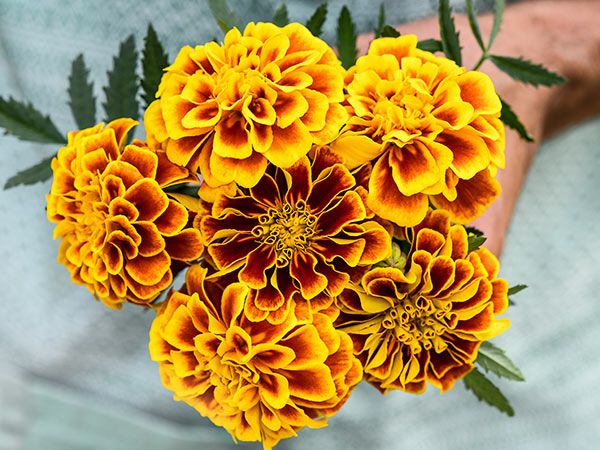The Colossus Red Gold Bicolor marigold is a spectacular variety known for its gigantic, vibrant blooms in shades of brilliant orange and deep red. This marigold combines the best traits of traditional French and African marigolds into one sensational flower that steals the show in any garden.
In this article, we’ll explore why Colossus has become so popular how to grow it successfully and tips for enjoying its fantastic flowers all season long.
Overview of Colossus Red Gold Bicolor Marigold
Colossus marigold is classified as a French marigold (Tagetes patula) and exhibits the dense mounded growth habit typical of this group. The plants reach about 12 inches tall and wide making them a great compact option for containers and edging flower beds.
While most French marigolds have small, single flowers, Colossus breaks the mold with its enormous double blooms. The vibrant bicolor pattern of deep orange petal bases that graduate into intense red tips is eye-catching.
The flowers measure 2-3 inches across, which is gigantic for a French marigold. In fact, the blossoms are nearly the size of large African marigolds. Hundreds of these showy flowers blanket the plants all summer long.
Key Features of Colossus Marigold
Some of the noteworthy attributes that make Colossus a top pick include:
- Massive flower size and unique bicolor pattern
- Continuous blooming from early summer until frost
- Compact, uniform growth habit perfect for edging and containers
- Excellent heat and drought tolerance
- Prolific flowers great for bouquets and garden decoration
- Attracts beneficial pollinators like bees and butterflies
With its top-notch ornamental qualities, it’s no wonder Colossus has won prestigious awards like All-America Selections Winner and Fleuroselect Gold Medal.
Growing Colossus Marigolds from Seed
Colossus marigold is best grown from seed sown directly in the garden after danger of spring frost has passed. Here are some tips for success:
- Sun Exposure: Give plants full sun – at least 6 hours of direct sun daily.
- Soil: Grow in average garden soil with good drainage. Avoid wet, heavy clay soil.
- Planting: Sow seeds 1/4-1/2 inch deep and 6-12 inches apart. Thin seedlings.
- Water: Water weekly during dry periods, taking care not to overwater.
- Fertilizer: Apply a balanced flower fertilizer once or twice during the season.
- Maintenance: Pinch back tips to encourage bushy growth. Deadhead spent blooms.
- Hardiness: Hardy in Zones 9-11 as a perennial. Grown as an annual in cooler areas.
With minimal care, Colossus will reward you with masses of vibrant blooms within about 8-10 weeks of sowing seeds.
Tips for Getting the Most Flowers
Follow these tips to maximize the number of flowers on Colossus marigolds:
- Give plants a sunny location with at least 6 hours of direct sun daily. Insufficient sunlight leads to reduced flowering.
- Provide adequate space between plants to allow for good air circulation. Crowding causes issues like powdery mildew.
- Deadhead spent flowers regularly to promote continuous reblooming throughout the season.
- Apply a soluble bloom-boosting fertilizer monthly to nourish plants and stimulate flowering.
- Avoid excess nitrogen fertilizers which lead to lush foliage at the expense of flowers.
- Monitor for common marigold pests like spider mites. Control with insecticidal soap or neem oil sprays.
- Water thoroughly during drought and extreme summer heat which can cause flower bud drop.
Using Colossus Marigold Flowers
The vibrant, long-lasting flowers of Colossus marigold make it a great choice for:
- Cut Flowers: The large, double blooms work beautifully in summer flower arrangements.
- Bedding Plant: Its uniform shape makes it perfect for edging borders or mass plantings.
- Containers: Plant in mixed patio pots or standalone thriller in container gardens.
- Companion Planting: Interplant with vegetables like tomatoes as a beneficial insect attractor.
- Wedding Flowers: Use the golden orange blooms in bridal bouquets and centerpieces.
No matter how you use them, Colossus marigolds will brighten any space with their spectacular colors and prolific flowers.
Alternate Marigold Varieties
If you love the Colossus marigold, consider also trying these top-rated varieties:
- Mr. Majestic – Giant 4-5 inch double blooms in bold red, yellow and orange.
- Durango Red – Vibrant red flowers on uniform, compact 10 inch plants.
- Boy Orange – Early to bloom with bright, crested orange flowers great for edging.
- Disco – Eye-catching shades of yellow, orange, red and mahogany with unique bicolor patterns.
- Queen Sophia – Burgundy red flowers on compact 10 inch plants, lovely for containers.
Explore different marigold types to find your favorites, though it’s hard to beat Colossus for sheer flower power!
The Dazzling Colossus Marigold Brightens Any Garden
With its nonstop harvest of giant, bicolor blooms, it’s easy to see why Colossus has become a modern marigold classic. This compact variety combines excellent landscape performance with spectacular floral display. Give Colossus marigolds a spot in full sun and get ready for a summer of vibrant color!
★ How to Grow Marigolds from Seed (A Complete Step by Step Guide)
FAQ
How tall are colossus red gold bicolor marigolds?
What are the best tasting marigolds?
Do marigolds come back every year?
Do marigolds need full sun?
- The Ultimate Guide to Growing Strawberries in Raised Beds - August 8, 2025
- No-Dig Garden Beds: The Easiest Way to Grow a Beautiful Garden - August 6, 2025
- How to Protect and Preserve Wood for Raised Garden Beds - August 6, 2025

